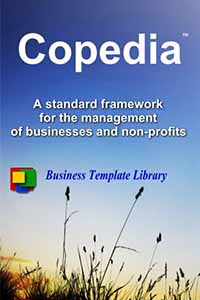How to create a SOP Template.
This page provides an example of how to document company policies and procedures by making a standard operating procedure template.
What is a Corporate or Business Standard Operating Procedure - SOP?
Company and corporate policies and procedures prescribe how an entity will function and be administered. They are the rules and methods of conducting business and often reference the entities internal controls and best practices.
What are internal controls and how do they relate to SOPs?
Internal controls refer to processes that help ensure efficiency of operations, including the safeguarding of assets, achievement of goals, the reliability of information reporting and compliance with laws and regulations. Proper internal controls must be incorporated into business policy and procedure documents.
Purpose
This document describes the process of documenting policies and procedures and provides guidelines for development. Following is a Standard SOP Template for documenting policies and procedures.
Discussion
The discussion sections provide background information, include definitions, responsibilities, controls, policies and
Definitions
The definitions section will help clarify your document and educate readers not familiar with industry specific terms.
Purpose and Mission
All enterprises have a purpose and mission. Since policies and procedures ultimately support a mission, review your organizations mission statement, if available.
Strategy
The Strategic Plan is the master plan, blueprint, or game plan indicating how the organization will achieve its purpose and mission. It is developed for corporate, line of business, functional, and operating levels. Policies and procedures will help you implement your plans and reduce business risk.
Policy
A course of action or rule adopted for prudence or expediency in order to implement strategy or achieve the mission.
Procedures
Specific conduct, methods, routines, processes, and actions used to complete tasks and comply with policies. Procedures are normally tied to policies but may simply be an instruction sheet on how to do something - like the procedure for changing the toner in your fax machine.
SOP - Standard Operating Procedure
SOPs are a standard way of performing tasks to achieve a consistent outcome, ensure quality and implement best practices. For example, a consistent outcome may be producing accurate financial statements on a monthly basis or ensuring a safe workplace or using professional techniques for hiring, onboarding, managing and terminating employees. The standard procedures used to produce the corporate financial reports are located in the company's accounting manual. The standard operating procedures for a safe workplace are contained in the company's safety manual. The standard operating procedures for conducting a new employee interview are contained in the company's HR Manual.
Internal control
The process of ensuring the procedures and policies adequately support the strategy and mission. Internal control is accomplished by implementing practices to protect assets, produce accurate and reliable information reporting and comply with laws and regulations.
General Management
The overall flavor, tone, and direction provided by the senior managers and directors of the enterprise. Your policy and procedure documents will convey flavor and tone by the way they are written and communicated.
Why put Policies and Procedures in Writing?
Governance
-
To maintain control and describe the method and systems of management.
Compliance
-
To comply with DCAA, Sarbanes – Oxley, government regulation, and certain audits
-
To comply with best management practice standards.
Communication
So the employee’s, customers, and stakeholders can read them
Mandated by compliance requirements
Continuity
To provide for management continuity
Education
To educate people about the entity.
To train new employees
Who uses Policies and Procedures?
Employees, Managers, Owners/Shareholders, Directors, Customers, Members are all your audience. Write your policies and procedures for a wide audience.
Time Commitment
Many people want to know how long it takes to document their policies and procedures. Time to produce documentation, of course depends on your knowledge level, writing skills and the amount of material you plan to cover. Generally, for short documents you may want to plan on 1 to 4 hours per page – start to final edit. On longer and more complex works you should plan on 4 hours plus per page starting with research and completing with publication.
How to write Policies and Procedures
If you are not familiar with what you plan to write about, then you need to begin by learning more about the subject matter of your document.
If you are developing a manual, you should begin with a flexible table of contents. Individual policies and procedures are like short articles on a specific topic.
This document provides the correct form, content, and format for your polices and procedures. Your policies and procedures must exactly maintain a consistent format and layout. You can personalize your documents, but each policy and procedure document should:
-
State its purpose or intent
-
Explain how it is related to the overall management system
-
Clarify its scope
-
Provide any definitions that will help clarify the document
-
Detail any controls that must be applied
-
Explain how authority has been divided and distributed
-
List the responsibilities and tasks that should be performed
-
Identify who is responsible for performing the tasks
-
Describe the tasks
-
Specify how and when the tasks should be performed
-
List any materials and supplies that must be used
-
List any tools and equipment that must be used
-
Review the document properties and control
Separate Policy from Procedure
Write the Policy-
First, begin with the policy.
-
Second, write the Procedures.
For example, assume you are writing “policies and procedures” for oil changes for company owned vehicles.
Begin with the policies or rules:
- The business will properly maintain its vehicles
- This policy applies to passenger vehicles and primary drivers
- Only qualified and approved vendors will be used for maintenance
- Oil will be changed every 3 to 4 thousand miles
- Tires will be rotated every other oil change
- A vehicle maintenance log will be kept in the vehicle glove box
Next, write the procedures:
- Accounts payable publishes an approved vendor list
- Vehicle maintenance will be scheduled by the primary driver
- The primary driver completes the maintenance log
- The maintenance log is turned in to the fleet manager annually
Consider controls to ensure the policies and procedures are effective.
The vice president will have the maintenance logs verified semi-annually.
Keep it simple
Simple means short and not complicated.
Style
Style is personal. Ours is quick and to the point with a minimal amount of on page formatting.
Format
Title Header
Each document needs a name. Use 2 to 4-word titles.
Purpose
Give a short description and reason for the document. Define the policies.
Details
You may have multiple subheadings within the document.
Try building your documents from the inside out rather than from beginning to end.
List the subheadings you want in the in the details section.
Build your text around the subheadings.
Format and Fonts are usually done last.
Length
Well written short documents are best by far.
Don't try impress with how big your book is or how many words in your document.
Fonts and Sizes
Title - Right justified, Tahoma 16pt font, color coded.
Headings - 14pt Tahoma Bold, Black
Subheadings – 12pt Arial Bold, Black
Body – Arial, 11 or 12pt –Black
Footer – Document Name and page number, right justified, 8pt Tahoma, color coded
Document Properties and Control
Policy and procedure documents must be controlled. We use the custom document properties feature in MS Word as much as possible. The following properties can be included directly in the document text.
Interpretation: Title
Identify the position responsible for interpreting and clarifying this document should any questions arise.
Authorization: Title
The position authorized to make changes to this procedure.
Date Accepted: Date
The date the document was accepted and put in effect.
Revision Information:
The date this document was revised and by whom. Describe any changes made and reasons for the revision.
Related Documents:
List and hyperlink any other documents that may be affected by changes or that are related to this document.
Records Management
Use this section to site your records retention policy for any procedures or forms referenced in this procedure.
Detailed Steps
Use this section to list and describe any detailed steps for tasks referenced in this procedure. Use bookmarks for quick links in the document.
Customize the Task Names.
Task Name
1. Step 1
Type a description for this step here.
2. Step 2
Managing Page Numbers and the Table of Contents
Policy and procedure documents are normally part of a manual or handbook. Your manual will likely be continually enhanced and modified. Therefore, simple page numbering and document labeling is important. The method we use is to build the Table of Contents in an Excel Spreadsheet. This enables users to sort the Titles on various criteria and easily build custom manuals with minimal effort. Try using the document name with the page number of the document in the footer as specified above. This technique will provide for maximum flexibility.
Templates
Our standard framework of pre-written templates will save you time and provide a professional and flexible solution. There is no reason to start from scratch or reinvent the wheel.

Templates Download in Word and Excel
All Templates download in MS Word and Excel for easy customization.
The Copedia Templates cover accounting, management, internal controls, human resource, workplace safety, sales and projects.
Compliance, Certifications, Accreditations
Copedia also provides a correct framework for compliance with ISO certification, Accreditations, Board requirements, and other government agency type audits which require that you have documented corporate policies and procedures, an internal control system, and an integrated risk management framework. The Copedia compliance templates and internal control evaluation tools, policy and procedures, and checklists provide the tools you need.

